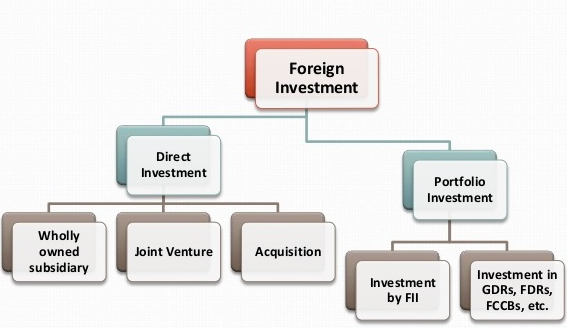Focus: GS-III: Indian Economy (Growth and Development of Indian Economy, External Sector)
Why in News?
The foreign direct investment (FDI) in the financial year 2021-22 has touched a “highest-ever” figure of $83.57 billion.
About Foreign Direct Investment (FDI)
- Foreign Direct Investment (FDI) is an investment in the form of a controlling ownership in a business in one country by an entity based in another country. It is thus distinguished from a Foreign Portfolio Investment by a notion of direct control.
- FDI may be made either “inorganically” by buying a company in the target country or “organically” by expanding the operations of an existing business in that country.
- Broadly, FDI includes “mergers and acquisitions, building new facilities, reinvesting profits earned from overseas operations, and intra company loans”. In a narrow sense, it refers just to building a new facility, and lasting management interest.
FDI in India
- Foreign Direct Investment (FDI) is a major driver of economic growth and an important source of non-debt finance for the economic development of India.
- It has been the endeavor of the Government to put in place an enabling and investor friendly FDI policy. The intent all this while has been to make the FDI policy more investor friendly and remove the policy bottlenecks that have been hindering the investment inflows into the country.
- The steps taken in this direction during the last six years have borne fruit as is evident from the ever-increasing volumes of FDI inflows being received into the country. Continuing on the path of FDI liberalization and simplification, Government has carried out FDI reforms across various sectors.
FDI Routes in India
- Foreign investment was introduced in 1991 under Foreign Exchange Management Act (FEMA), driven by then FM Manmohan Singh.
- There are three routes through which FDI flows into India. They are described in the following table:
| Category 1 | Category 2 | Category 3 |
| 100% FDI permitted through Automatic Route | Up to 100% FDI permitted through Government Route | Up to 100% FDI permitted through Automatic + Government Route |
- Automatic route: By this route, FDI is allowed without prior approval by Government or RBI.
- Government route: Prior approval by the government is needed via this route. The application needs to be made through Foreign Investment Facilitation Portal, which will facilitate the single-window clearance of FDI application under Approval Route.

- Global Depository Receipts – GDR
- Foreign Depository Receipts – FDR
- Foreign Currency Convertible Bonds – FCCB
- Foreign institutional investors – FII
Government Measures to Promote FDI
- Factors such as favourable demographics, impressive mobile and internet penetration, massive consumption and technology uptake, played an important role in attracting the investments.
- Launch of Schemes attracting investments, such as, National technical Textile Mission, Production Linked Incentive Scheme, Pradhan Mantri Kisan SAMPADA Yojana, etc.
- The government has elaborated upon the initiatives under the Atmanirbhar Bharat to encourage investments in different sectors.
- As a part of its Make in India initiative to promote domestic manufacturing, India deregulated FDI rules for several sectors over the last few years.




